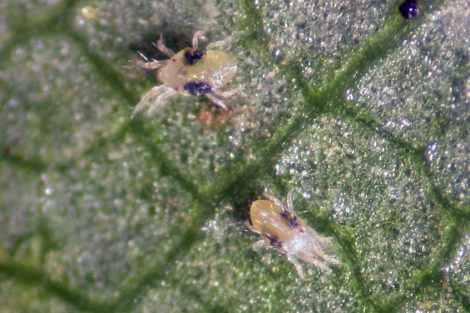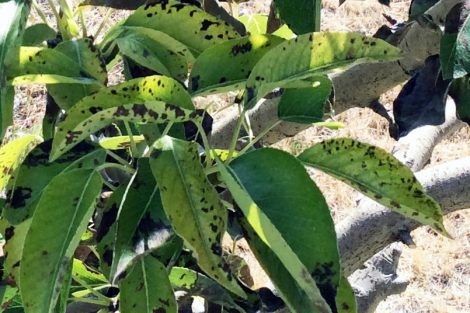In this Issue
- Apple and Pear: updated dates for codling moth egg hatch; pear psylla damage; white apple leafhopper nymphs
- Cherry, apricot, peach/nectarine: cherry fruit fly post-harvest; continue protecting trees from greater peachtree borer; watch rain to prevent cornyeum blight
- All tree and small fruits: earwigs; spider mite injury is common; iron chlorosis
APPLE, PEAR
Codling Moth
provide continuous protection of fruit until Sept. 15

View a pdf of the spray timing table. Be sure to read the instructions at the top of the page, for how to read the table. (Note: some dates are in italics because they are past dates.)
Most areas are approaching the end of second generation egg hatch. The start of the third generation egg hatch will only be a few days later. Therefore, it is important to maintain protection of fruits regularly until September 15, or harvest (whichever is earlier). (Mid-September is the time when the eggs stop hatching due to shorter day-lengths.)
Pear Psylla

look for damage
If you had not noticed the presence of pear psylla this spring, damage is evident by now (and has been for a few weeks). This insect is active from spring to fall, and if left unchecked, can build to damaging levels. As they feed (mostly on the undersides of leaves), they suck plant sap and excrete copious honeydew. As they feed, the plant tissue dies, resulting in what looks like scorched foliage.
At this point in the growing season, all life stages can be found, including adults, eggs, newly-hatched nymphs, and older nymphs. The best timing for treatment is in spring, but if necessary, treat now to avoid further population buildup.
Treatment
- Residential: horticultural oil (1%; apply when temperatures are below 85°F)
- Commercial growers can use Actara, Admire Pro (or generics), Agri-Mek, Assail, or Delegate. Click here for more information.
White Apple Leafhopper
will be a nuisance at picking if not treated now
Where present, feeding damage from the second generation of leafhopper nymphs can now be seen on the foliage. Older nymphs are active mainly on the undersides of leaves. If your trees had a high population of the first generation, now would be a good time to treat to prevent a nuisance of adults during harvest. Nymphs are easier to treat than the adults because they are less mobile. Adult activity will become very noticeable by late August.
Note that feeding on the foliage will not affect apple yield or tree health.
Treatment
- Backyard growers can use 1% oil, insecticidal soap, or Safer BioNeem
- Options for commercial growers: click here.
CHERRY, PEACH/NECTARINE, APRICOT, PLUM
Western Cherry Fruit Fly Post-Harvest

don’t forget about the fruit left on the tree
Cherry fruit fly activity peaks AFTER harvest, and untreated fruit that remain on the tree represent a source for infestation the following season. In commercial orchards, apply an insecticide such as imidacloprid (Admire Pro, or generics) within seven days after harvest to reduce fly populations for the following year, especially in orchards with high post-harvest catches. Dimethoate plus 1% oil is another option.
For backyard trees, please remove and destroy all fallen fruit, and if possible, pick your cherry trees clean to remove egg-laying sites for late-emerging fruit flies. Please play your role in keeping your trees clean of this pest that can devastate a commercial growers’ crop.
Greater Peachtree Borer (For Backyard Growers)
continue protection of trunk through mid-October
Continue to maintain protection of the lower trunk of peach/nectarine and apricot (where necessary) with your last treatment around September 15 (so that the trunk is protected through Oct 15). When you spray, be sure to move mulch or weeds away from the trunk (or even excess soil) because sometimes eggs are laid below grade.
This fall or next spring, determine the success of your treatment program by inspecting your trees. Remove dirt from around the base of the tree down to about 4 inches. Look for oozing gum mixed with frass. If you find any symptoms, you will know that you need to improve your control program for next year.
Treatment
Backyard growers can use Hi Yield Permethrin, Sevin, Spectracide Triazicide, or for organic control, products containing spinosad.
Coryneum Blight

rains can bring on infections of fruit
With the monsoonal rains to come, there is a risk of late-season infections occurring on the softening peach fruit. These infections look different from early-season infections. Sometimes, the damage will not show up until after harvest.
Protection against late season infections on ripening fruit is particularly important where there is a history of this disease. During the three to four weeks before harvest, be diligent about monitoring your fruit, and apply a protection before a forecasted rainfall (ideally).
At least 4 hours of rainfall and temperatures of 70 to 80°F are optimal conditions for infections. New infections are visible on maturing fruit in a matter of 2 to 5 days, and most often, render the fruit unsalable. Additional infections can spread rapidly within an orchard or individual tree.
Treatment
- Residential growers can use Spectracide Immunox or Captan.
- Commercial growers options: click here.
ALL FRUITS
Earwigs
Earwig populations are high this season in many locations. They do not like dry conditions, so they are concentrated in areas that are irrigated and have moist, cool places to hide during the day.
Earwigs can cause fruit damage by feeding directly on the fruit skin and flesh, or entering fruit such as peach and feeding near the pit. If the fruit is still hard, they will feed on leaves or other insects. They feed mostly at night, leaving behind trailing dots of black excrement.
Treatment
To manage earwigs, use a variety of options:
Trapping: For small farm or backyard situations, regular trapping is a highly effective tool. Traps made with smelly oil work particularly well. A small container (plastic or tuna can-type) would be filled with about a half inch of fish oil, bacon grease, or a mix of soy sauce plus cooking oil. Place the container on the ground in hot spots and clean them out and refill daily until very few are captured. Other trap options include rolled-up news-paper; rolled up corrugated cardboard; bamboo sticks; or short pieces of hose. These types of traps can be thrown out and replaced each morning.
Sanitation: Earwigs hide in dark, moist environments. Where possible, keep mulch away from trees and remove weedy growth or groundcovers from the base of trees. Remove tree suckers or any limbs touching the ground. Remove loose bark on fruit trees where earwigs can hide.
Sanitation: Pick fruit as soon as it starts to ripen.
Insecticides: Some insecticides are effective against earwigs. Spinosad kills earwigs after they feed on the residual material. It can be used either as a spray (Success, Entrust) or bait sprinkled at the base of trees (Sluggo Plus). (In this method, the bait must be used before the earwigs enter the tree. Otherwise, sprinkle bait in tree crotches.) Carbaryl can also be used, applied to the tree trunk and scaffold limbs, but again, it must be applied as soon as earwigs are starting to enter the tree.
Spider Mites
Spider mite activity is high this summer on apples, peaches, cherries, raspberries, and other crops. The heat of our current summer has helped populations to spike across the state.
Check for mites by examining the leaves on lower branches. (Mites overwinter in groundcover and migrate up the tree in hot, dry weather.) Look for leaves that are stippled, and turn them over. Using a hand lens, look for the slow-moving mites.
Before making a decision on whether to treat, also look for predatory mites within the pest mite population. These are fast-moving mites, about the same size, that can prevent spider mite densities from exceeding economic thresholds. If predators are present, then a treatment may not be necessary.
Damage on pear is different, in that leaves turn a blotchy dark brown to black, especially if there is heavy feeding over a short period of time. In addition, new foliage may also be affected, even if mites are not present. The damage may resemble heat scorch or pear psylla feeding. The recommended action threshold for pears is very low: an average of 1 spider mite per leaf. Anjou and Bosc are particularly susceptible.
Treatment
A 0.5-1% application of horticultural oil is very effective on mites, especially when populations are low, and when the spray coverage is good enough to cover the undersides of the leaves. Repeat on a regular basis or mix the oil with other sprays.
Spider mite options on tree fruits for commercial growers. (Select the crop, and then select “fruit present” stage.)
Iron Deficiency

Iron chlorosis is common on fruit trees every year in Utah. The problem is not caused by a lack of iron in the soil, but rather the soil pH (which ranges from 7.5 to 8.5). In high pH, iron is insoluble, and therefore not available for root absorption. Because irrigation water is also very alkaline, trying to manage iron deficiency by reducing soil pH is impossible.
Iron deficiency is exacerbated by frequent springtime irrigation, prolonged soil wetness, or an uneven root to shoot ratio. Iron is a nutrient necessary for the formation of chlorophyll. Iron-deficient leaves have interveinal chlorosis (yellowing between veins). In severe symptoms, leaves may show blackened scorching, curling, or premature drop. Some trees are genetically more susceptible to nutrient deficiencies than others.
To prevent or treat iron deficiency, chelated iron should be applied to the soil in spring before budbreak. The best form of chelated iron to use is EDDHA, sold as Sequestrene or Miller’s Ferriplus. Usually one application is good for the entire season, but must be repeated again the following spring. To get the iron to the roots, it may be applied in trenches dug within the root zone or in soil plugs around the drip line.
One reader of our pest advisories has had great success with Baicor Iron Tree Treats, (made locally). He recommends, “Drill 3/8-inch holes 12 inches above ground in tree trunk. Insert iron cylinders and cover with grafting wax. $23 for 15 capsules.”
Later in the season, foliar iron sprays (0.1%) with a spreader-sticker provide quick results but must be reapplied at approximately 10- to 21-day intervals. The drawback of foliar sprays is that staining of fruit can occur.
To be sure of the correct nutrient deficiency, the USU Analytical Lab (435-797-2217) can test foliar and soil samples. Early August is an excellent time to get foliar nutrient analysis in preparation for next year’s nutrition program.












